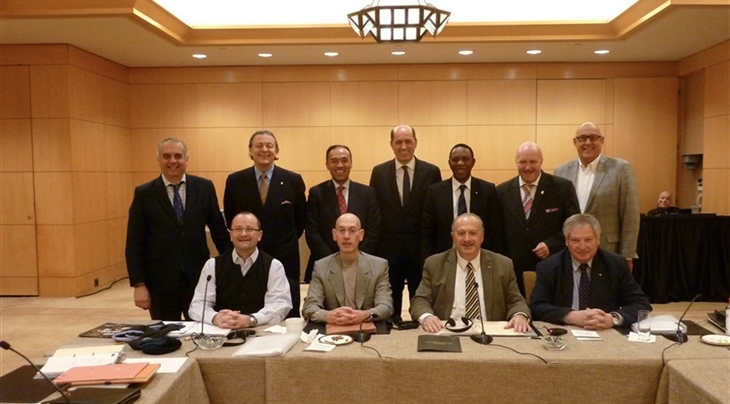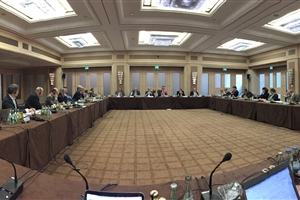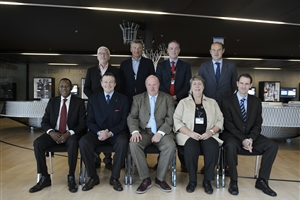
Muratore: "Plenty of opportunities lie ahead for FIBA, NBA, National Member Federations and leagues"
MIES - FIBA President Horacio Muratore has been very busy since being elected to head the world governing body of basketball for the 2014-2019 term of office at last August's FIBA World Congress in Sevilla, Spain.
He recently talked to FIBA.com, reflecting on his first few months on the job and outlining how things are progressing in a new era for the International Basketball Federation.
FIBA: It's now a little over six months since you began your term of office as President of FIBA. Can you share with us some of your main thoughts?
Muratore: At the first Central Board meeting for the 2014-2019 cycle, we were conscious of the enormous task at hand and the lack of time. This is the main challenge to achieving all of our objectives.
We need to consolidate and implement the new competition system as well as keep pushing our 3x3 discipline to reach its full potential.
As ONE FIBA, we want to take advantage of the new governance model to build new strategies that allow us to open new routes and institutional cooperation. If we manage to do this, the project will fill us with a lot of satisfaction. For this, we need to work closely with our National Member Federations. We have to make sure they understand the need to adapt to the current basketball and FIBA reality.
To implement the new competition system, we want to have 140 countries ready to play in 2017.
We knew that by completing the construction of the House of Basketball, another pillar would take its place and this one is to get closer to our National Member Federations and to help them to develop basketball in their countries. We need to grow basketball in every country to be able to reach all these objectives. For this to happen, we need to improve the administrative and sporting organisation of all our members so that they are able to restructure and strengthen basketball in their countries.
We have specific long-term plans, because helping our members cannot be done in one or two years, but implies committing ourselves to a five- to seven-year cooperation with the different federations.
Our idea has always been to work on the ground together with the National Member Federations. - Muratore
We want to call out to the National Member Federations, see what their needs are and to find the best technical experts to assist them. This is the main role of the Zones and the Regional Offices.
FIBA: How is the work progressing in terms of having 140 National Member Federations ready to take part in the new qualification system for the 2019 FIBA Basketball World Cup?
Muratore: There are obviously national federations that are leaders and are used to playing at FIBA events. They are followed by others who have significant performance levels but who are less used to playing internationally. These are the ones we want to concentrate on because they will play under the new competition system right from the start, in November 2017. Then there are others with moderate performance levels which we would like to see increase so that they can be at the level of the first two groups. There are national federations that are ready to play and others that are not just yet.
The work has already begun with the working groups [Working Group on National Federations Support and Development] having met, put important issues on the table and prepared a concrete programme for the development of the national federations.
Last week, we organised a meeting with all the Chair Persons and Deputy Chairs of the FIBA Commissions and of the FIBA Zones Committees, with the Regional Directors all present. This was important because we wanted to inform them of our priorities and have them shape those for the future.
It is important to see in which ways each commission can help implement the new governance and new competition system and also in the long run, for the full 2014-2019 term, what topics they could work on.
FIBA: Can you talk about the Executive Committee and how its implementation has helped so far?
Muratore: The Executive Committee is the organ that helps FIBA execute its strategies which are defined by the Central Board. According to our new statutes, the Central Board is the one that sets the strategy on behalf of the Congress. We want the Congress to be more participative now, and for participants to not just attend and listen to reports. The Executive Committee is the body which has been delegated by the Central Board to help execute and assist the Secretary General. We have separated the political aspects from the operational ones.
FIBA: How can you best sum up the new functions that make up the roles of the Regional Offices and of the Regional Directors?
Muratore: In each FIBA Zone (Africa, Americas, Asia, Europe and Oceania), a regional office has been created. The Executive Committee has nominated all the Regional Directors, who must reach all the National Member Federations in their respective region and help develop basketball there. They must exclusively dedicate themselves to helping the National Member Federations develop basketball in each country and organise the zone events. These are their main tasks.
There are countries for which 3x3 is the ideal way to develop basketball. - Muratore
FIBA: How important is it to spread the word to all 214 National Member Federations about their need to implement a 3x3 programme?
Muratore: It's essential. There are two ways to grow a sport from the grassroots up: by organising mini-basketball and by using 3x3. 3x3 is an excellent way to help grow basketball and bring international participation in this new discipline. We are also looking forward to having it included in the programme of the Tokyo 2020 Olympic Games.
FIBA: FIBA and the NBA have enjoyed a special bond for more than 20 years, but that relationship goes up another notch with the appointment of NBA Deputy Commissioner Mark Tatum as the NBA Representative on the Central Board and as a member of the Executive Committee.
Muratore: We have always cooperated well with the NBA. Now, the inclusion of a member of the NBA on the Executive Committee, combined with the fact that the NBA is present at the discussion table and involved in thinking together with us on the development of our sport, can only be good for world basketball.
Mark Tatum is the perfect person to represent the NBA. He has all of Adam Silver's trust and it is also important for them, as the biggest national basketball league in the world, to be on board with us, to present their point of view on the work we do and to see up close what our objectives are and how we can help each other.
Both Adam Silver and Mark Tatum paid a visit to the House of Basketball back in January and together with FIBA Secretary General and International Olympic Committee (IOC) Member Patrick Baumann, they met the IOC President in Lausanne.
The fact that Adam Silver and Mark Tatum visited the IOC with FIBA and spoke about the future of basketball at the Olympics, is a strong indication of our special bond, but also is a sign for the IOC to see how we share together a vision for the future. I was also very interested in the new objective of the NBA in 3x3. They are also working with 3x3 and it will be very important in the future.
We have many common objectives with the NBA. One is to better manage domestic and international leagues and to help them grow. - Muratore
FIBA: What can FIBA learn from this closer cooperation with the NBA?
Muratore: The NBA has a great experience in club competitions and this is important for us. I think it's important to point out how FIBA wants to include and respect clubs and national leagues. Our objective is that our national leagues grow. This is where the referees, officials, technical experts and specialised journalists are born and develop in great numbers. They are the ones that value and push our sport. It is also important for FIBA’s stakeholders, our partners and sponsors.
I always believed the club leagues were important to develop our sport. Twenty years ago, I created the Liga Sudamericana (South American League) which has been recognised by FIBA and the NBA as a top-level league and has reached amazing levels. I was also able to help consolidate the DIRECTV Liga de las Americas FIBA (Americas League) as FIBA Americas Vice President and then President.
At the same time, the NBA travels the world, much as we do and it is critical to jointly exchange views, make the most of opportunities and resolve concerns from all those visits.
The NBA invited us to the All-Star Weekend in New York and we held an informal Executive Committee meeting there. The participation of Adam Silver in that meeting, with him listening, contributing and explaining the NBA's objectives, was very positive. This speaks clearly to the fact that, with his and Mark's participation in the discussions, the relationship is going to improve even more and consequently international basketball has bright days ahead to look forward to.
The fact that we're concentrating our efforts to help develop National Federations is a great moment for FIBA. - Muratore
FIBA: On a lighter note, can you share with us what you like about being FIBA President? What drives you, what is your motivation?
Muratore: I have always worked in this area [development]. This is one of the things I like the most because I have done this all my life at all levels in every place I have worked in.
I like the respect towards the National Member Federations and getting closer to them. They are the base of our sport, they are our affiliates. And the fact of being at their side is what I most like in this new vision of FIBA. Each federation may need a different type of support, big or small. To be able to provide assistance adapted to their needs makes me very happy.
FIBA: What are the next steps?
Muratore: We have a very important meeting of the Executive Committee later this week [12-13 March] and the Central Board will meet in June.
FIBA
















